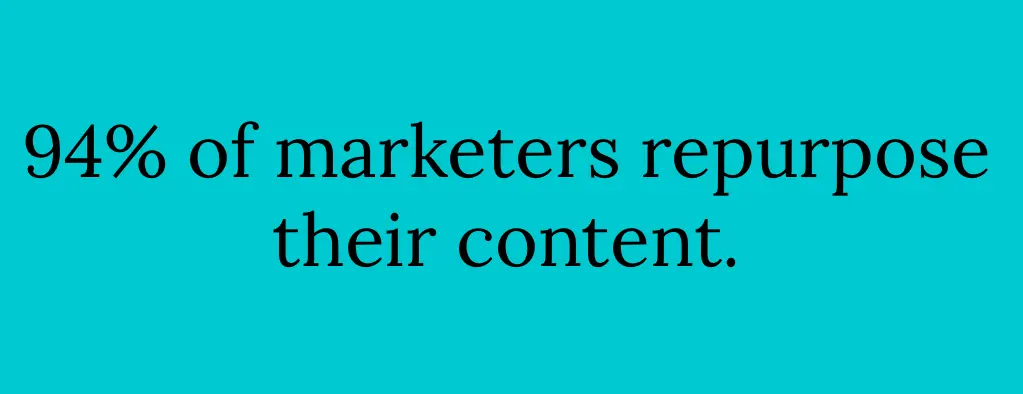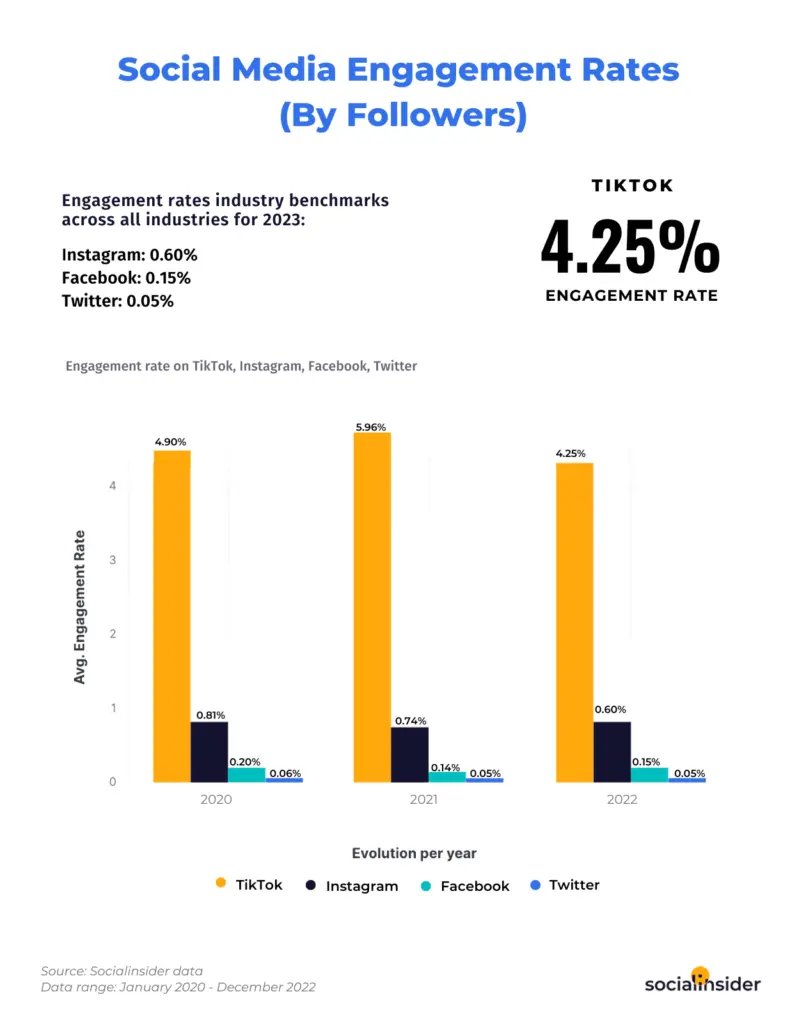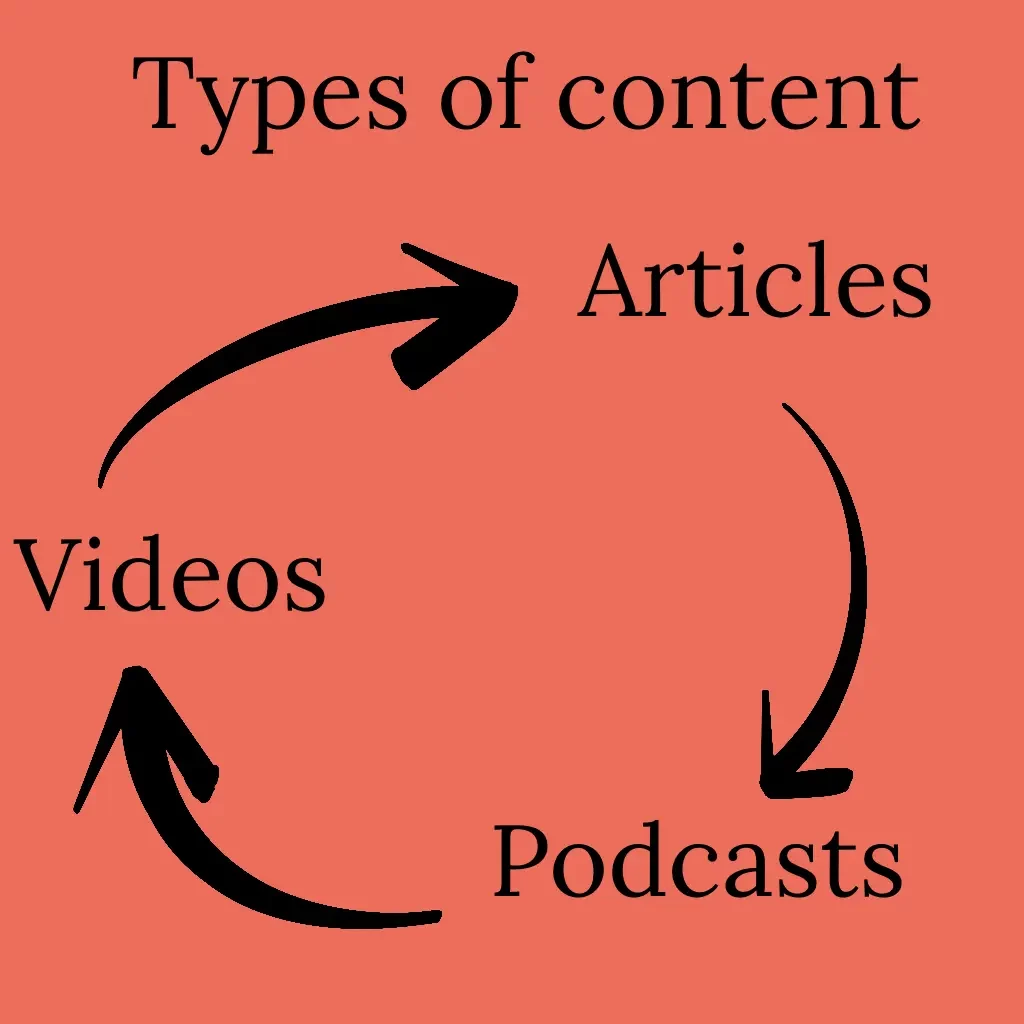Ever wonder how creators find the time to create so much content across multiple channels? One of the keys is content repurposing.
Content repurposing is simply taking existing content and presenting it in different formats or across various platforms.
You probably can think of a few creators and even colleagues that seem to always show up in your feeds – whether sharing their stories, useful carousels or hosting webinars, you can’t ignore them.
94% of marketers repurpose their content – and it’s not just companies with huge budgets.

In today’s ultra-competitive landscape and ever-evolving search algorithms, creating high-quality, fresh content regularly is crucial for success online. So how does a busy entrepreneur keep up with the content, especially with AI making it easier to publish quickly?
If you’ve ever struggled for ideas or don’t think you have the time to create a steady stream of content, we have a few tips on what types of content work best for repurposing so you can get started creating useful content faster, while reaching a wider audience AND improve your brand visibility.
The Key to Content Repurposing
The key to repurposing content is to continuously make your content better by focusing on what’s performing well. The one thing you should not do is simply copy and rehash what you already have without thinking.
Instead, for articles, check your analytics (Google Search Console or Google Analytics) for those performing the best. For videos, monitor your views. For social media posts, check which have the highest engagement. Depending on your traffic, adjust how often you check.
You can also set email alerts in these tools when traffic hits a certain threshold – more convenient than constantly checking stats!
Then take the best posts, and start repurposing!
This Still Sounds Like a Lot of Work!
Still not convinced?
It’s much easier to take an existing piece of content and repurpose it than creating a whole new piece – for instance taking a snippet from a webinar or a pull quote from an interview.
And once you create the habit and have your Canva or Figma templates set up (hire a freelancer if you need help – there is no shortage of graphic designers), it’ll take you minutes instead of hours.
There are so many advantages to repurposing content, but for this article we’ll go deeper into four key benefits:
- Saving time
- Attracting people from multiple channels
- Establishes brand voice
- Double down on high-performing content
Saving Time
Have you ever edited an article instead of writing one from scratch?
When you don’t have to brainstorm completely new ideas and carry out original research, it takes so much less time to make new content.
At first there was the word processor (WordStar or WordPerfect anyone?). Then came spell check, then Grammarly, and now we have generative AI writing assistants that can write a 1,000 word blog post in minutes (not this one – no surprise in the conclusion here).
Writers who use AI are doing really well today – they’re using the tools to speed up their process.
Repurposing is a tactic that, when using the right tools, saves you so much time without sacrificing quality. In fact, tools help us identify what content to focus on. Just remember not to sacrifice quality along the way.
Attracting People from Multiple Channels
A proven method of increasing web traffic is to be visible on multiple relevant channels.
Different demographics hang out in different places, and they’re behavior is changing as well. Just check your average Facebook thread vs Instagram and TikTok to see how different the general tone is.
This chart shows a decline in engagement year over year and the difference in platforms:

Source: SocialInsider
We all know those lurkers who never post on Facebook, yet they know all of your updates. Or people who are very active on Instagram, but stay away from LinkedIn. People naturally will prefer one channel over the other – I know my older, retired family members spend the most or their screen time on YouTube.
Repurposing content helps you reach these different audiences. You can take one idea and repackage it for multiple channels.
Let’s say you just finished a webinar, which is still one of the best ways to get in front of people. But most people won’t attend it. They might watch the replay, but then they’ll forget. And then there’s the majority who may have seen you promote it but will never see it.
An easy way to repurpose is take the Q&A section and make that a social media post or short video. Take the key points in the webinar video, and make a LinkedIn carousel. Link to the full replay on the last slide. Sum it up in a blog post. You can see how one webinar can lead to countless content ideas.
New channels means new audiences, so not only will you reach new people, you’ll get different perspectives.
Establishes Brand Voice
Establishing a brand voice takes consistency. I often talk to small business owners reluctant to post on LinkedIn, though they know and see the value. There are so many lurkers who don’t engage, but they see your posts.
I made a quick LinkedIn post about a Canadian government grant we’re certified advisors for. It got fewer than 20 likes and 5 comments. But the day after, an old friend I haven’t talked to in over a decade reached out, and they ended up hiring us to help with their marketing strategy.
This is staying top of mind. When the time comes and someone has a problem and is searching for a solution (they’re in the BOFU stage), they remember that webinar you promoted multiple times last week,
Customers are human – we recognize what is repeated. Make it easier for them to find you by going where they hang out.
Be consistent in your voice. That’s what those templates are for. Write a tone and style guide, or hire a branding agency to do it for you. This structure makes it easier to repurpose content and create quality content that connects.
Double Down on High-Performing Content
Content performance, like most things in life, trends towards the 80/20 rule: 20% of your content will be responsible for 80% of your conversions.
We’ve mentioned how you can configure notifications to ping you when certain pieces are doing well on specific channels. Where skill is involved is learning what makes that content stand out. This is out of the scope of this article, but in short, it comes with time and practice.
When you’re holding a webinar, the chat and the Q&A will often lead you to the most engaging parts. And the beauty of social media is the instant response you get to a post or comment. Double down on it by repurposing it into multiple pieces of new content.
Most industries have an online conversion rate of less than 3% so every little bit counts.
Content repurposing builds a habit that can create a content flywheel, focusing on content that’s more likely to succeed. And like most things in life, the more practice you put in, the easier it becomes.
It maximizes the value of existing assets by making assets more shareable, improves SEO, and expands your audience.
So now you know why to repurpose your content, let’s talk about the best types of content for repurposing.
The Best Types of Content to Repurpose
While all kinds of content can be repurposed, podcasts, articles, videos, and webinars are great starting points simply because of the sheer amount of content you’ve already made.
Evergreen content is a particularly good candidate, because it tends to be general and appealing enough to map into different formats, and stays relevant.
For instance, start with an evergreen blog post, and make short video snippets and pull quotes for social.
Articles
Articles are the simplest kinds of content to repurpose. Since they’re mostly text, they can be easily turned into podcasts and videos. And if an article contains graphics, those graphics can also be included in a video.
Turning an article into a video can be as simple as reading the article aloud over a slideshow. However, it can pay to put in more effort than that.
Consider making it into a more video-friendly script, and talking directly to the camera for a more human touch.
You can also use the article as a starting point for a conversation to be used in a podcast or video. Instead of a strict script, the ideas in the article can be used as talking points, then let the conversation flow from there.
One trick for those who don’t have a large audience yet is to record a video of yourself from the side, talking into a mic and looking across the desk as if you were being interviewed. Talking into a microphone adds instant credibility!
Videos
Video content has proven once again to be the most captivating and engaging to audiences. However, the process of creating videos takes significant time, resources, and effort, which often means it sinks to the bottom of a busy business owners’ priority list.
Tools like Descript are making it so much easier to edit videos. It automatically transcribes videos so you edit text, instead of cutting by dragging sliders left and right.
Pronounced a name wrong or missed a key point? Instead of re-recording, Descript allows you to type in what should’ve been in the video, and their Overdub text-to-speech technology adds it to your video! Sounds like magic, doesn’t it? Good technology always does.
Videos come in many forms, so there may be many different ways of repurposing a video into other forms of content.
Strictly informational videos may already resemble blog articles in their structure. With a little tweaking, their script can be repurposed into an article, and you can use stills from the video as graphics.
Educational content is often recorded as an interview or webinar. Take snippets to make short-form videos and share them on social media. Create slides and use text-to-speech to create multiple pieces of educational content. One webinar can result in dozens of bite-sized educational videos, the perfect form for social.
Podcasts
Because podcasts are audio only, transcription tools like Otter.ai make it really easy to turn into articles – you have no excuses!
If the podcast host hasn’t already, simply publish a transcript from the podcast. Always ask for a backlink and/or a byline for SEO reasons.
You can also reframe the key points of the podcast in an article or a voice-over for a slide deck.

Conclusion: Remixing Content
When done right, repurposing content saves you time and makes your brand look consistent. Done wrong, repurposing content is repetitive and at its worst, trains people to ignore what you have to say.
Ask yourself these three questions before creating any piece of content:
- Is it educational?
- Is it inspiring?
- Is it entertaining?
The new content shouldn’t be a watered down version of the original. Instead, use it as an opportunity to highlight the best parts, and repackage in a way that’s more easily digestible. That’s why short-form content is doing so well and slideshows / carousels have made a comeback.
And with new AI tools coming out daily, there’s little excuse not to start writing and repurposing. Content creators that use these tools will have an advantage over those who do not. They’ll be able to pump out more content faster, and adjust to new audiences with ease.
Creators who master these skills will be ahead and stay ahead of the competition. One year from now you’ll wish you started writing a year ago. Even one article every two weeks is 26 articles a year.
What are you waiting for? Get writing, get repurposing!





